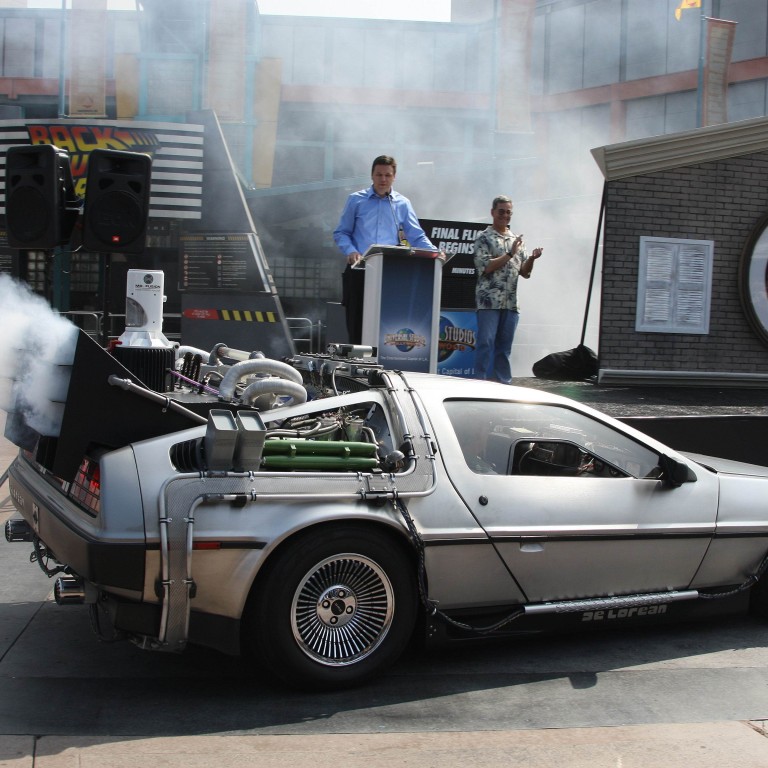
How accurate were Back to the Future II’s predictions about October 21, 2015?
The 1985 film showed flying cars, hoverboards, fax machines and beer-powered generators in 2015
Unlike its predecessor, Back to the Future Part II actually lives up to its name. In the wildly successful, franchise-spawning first film from 1985, teenager Marty McFly (Michael J. Fox) and friend Emmett “Doc” Brown (Christopher Lloyd) go back in time to 1955, but in the 1989 sequel they go forward, and then back, as they attempt to repair problems they caused by their time travel in the previous film, but actually end up creating as many issues as they solve.
And what unimaginably futuristic era do they leap forward to? Why, the hoverboard-hopping, driverless car-riding, techno-utopian dot on the space-time horizon that is 2015 – specifically, October 21, 2015, ie this Wednesday. So, with us all having lived through 2015 so far and witnessed all the wonderful technological advances of the era, we are in a position to judge how accurate the film’s predictions of the future were.
Back to the Future Part II visual effects art director John Bell has said that he only knew that the film would be set 30 years in the future and feature “something called hoverboards”, and the film’s vision of that future is a fairly gleaming, optimistic one, a 1950s Jetsons view rather than the bleak, Blade Runner-like dystopian gloom and grime that tended to dominate 1980s science fiction. But despite the fact that the film aims mainly for humour rather than accuracy in its predictions, it’s often surprisingly prescient – more so than most films that take the business of forecasting the future far more seriously.
So what did the filmmakers get right about Marty and Doc’s exotic world of the distant future, and what did they get wrong?

Hoverboards
Hoverboards are perhaps the film’s defining futuristic technology and one that everyone has always wanted to come true (director Robert Zemeckis claimed at the time that the hoverboards were real and were only kept out of the public domain for safety reasons; as a result people have been asking him since where they can get one). We have self-balancing scooters, a kind of skateboard-meets-Segway, but nothing that actually floats in mid-air. There are a couple of maglev-based boards in development, however: one from Japanese carmaker Lexus, and the Hendo hoverboard from US company Arx Pax.

Flatscreens
Big screens were already starting to take over in the ’80s, but not in people’s homes; one change the film entirely accurately predicts is the rise of flatscreen TVs. They’re used to watch up to six channels at once, including The Scenery Channel, a joke in 1989 but entirely plausible in today’s world of micro-niche programming. But 3D technology, commonplace today, is reserved for a holographic ad for the film Jaws 19 (right idea, wrong franchise).

Flying vehicles
Vehicles don’t just skim the ground in Zemeckis’ vision of the future: they also fly through the air, causing traffic jams on the airway. Flying cars are on the verge of existing now – US company Terrafugia and Slovakia’s AeroMobil have both developed prototypes – but they’re ungainly creatures, looking like flying vans when they’re in the air and squat insects when they’re on the ground. And sadly, unlike in the film, you can’t convert an existing road car into one.

The internet
Along with mobile phones, the film entirely fails to predict the internet – the plot hinges on the ability of Marty’s antagonist, Biff Tannen, to predict sports results in the past, thanks to information brought back from the future – in a book. It also has fax machines still in widespread use, shows us big piles of laser discs in a back alley, and has people mainly getting their information from newspapers. But there is a tablet-like device at one point, and there’s a glimpse into a possible cashless economy when a cab fare is paid using a touchscreen device. Neither do we yet have hydrators to cook miniaturised food in seconds, or sleep-inducing alpha rhythm generators of the sort liberally used by the Doc to knock people out. Most shockingly of all, however, time-travel-powering nuclear factories fuelled by beer are still yet to be invented. Give it time.

Video calls
Along with almost every ’80s sci-fi film, Back to the Future Part II features Skype-like video phone calls – but completely fails to predict that they’d mostly happen through phones. Personal information about the person on the other end scrolls along the bottom of the screen, fulfilling much the same contextualising role as social media does today. The film also features ubiquitous photography, using a camera that’s roughly the size and shape of a smartphone, but definitely isn’t one: despite mobile phones already existing in 1989, they are entirely absent from 2015. Google Glass-like head-mounted displays are there, though, and Wii/Kinect-like hands-free video gaming is implied when Marty’s skill on an old-school game machine is scorned by two small children.

Cosmetic surgery
Another fairly obvious extrapolation from the ’80s present was ubiquitous cosmetic surgery. Although the Doc’s full blood transfusion, hair repair and new spleen and colon appear to make no difference to his appearance, it’s fair to say that – in an echo of the first film’s slightly awkward Oedipal plot – Marty’s mother Lorraine’s surgical enhancements most definitely do.

Automation
Automation is everywhere in the film’s 2015. Cars essentially refuel themselves, dogs are walked remotely, the McFlys’ future home works by biometric scanning, and drones take photos for newspapers such as USA Today. Perhaps the most eye-catching automated technology, however, is Marty’s self-lacing shoes. Nike’s Mag Air, released in 2011, were designed as a replica of the shoes, but cheated by using elastic; a fully self-tying version is supposedly coming soon. No sign, however, of Marty’s self-fitting and self-drying clothing – which, weirdly, also seems to possess the voice of Stephen Hawking.

